 Proper basement waterproofing includes correct installation of basement footer drains, and is part of a comprehensive Mar-flex Waterproofing System. This is especially important in any area of significant annual rainfall because ground water saturation causes hydrostatic pressure on your foundation wall. Even dry and arid environments need some kind of minimal drainage solution because flooding can still happen under certain circumstances. Saturated ground causes hydrostatic pressure on basement walls and even pushes up on the slab/basement floor. This can lead to cracks, shifting, water damage, mold, mildew, flooding, and a host of other serious problems. Foundation drainage tiles were originally developed many years ago to help move subsurface water away from the foundation, and pipe it to a location where it can’t harm the structure. We have several drainage solutions to fit any size structure. Browse our selection today, and see what makes Mar-flex one of the most reliable manufacturers in the industry.
Proper basement waterproofing includes correct installation of basement footer drains, and is part of a comprehensive Mar-flex Waterproofing System. This is especially important in any area of significant annual rainfall because ground water saturation causes hydrostatic pressure on your foundation wall. Even dry and arid environments need some kind of minimal drainage solution because flooding can still happen under certain circumstances. Saturated ground causes hydrostatic pressure on basement walls and even pushes up on the slab/basement floor. This can lead to cracks, shifting, water damage, mold, mildew, flooding, and a host of other serious problems. Foundation drainage tiles were originally developed many years ago to help move subsurface water away from the foundation, and pipe it to a location where it can’t harm the structure. We have several drainage solutions to fit any size structure. Browse our selection today, and see what makes Mar-flex one of the most reliable manufacturers in the industry.
The Mar-flex Staple Kit
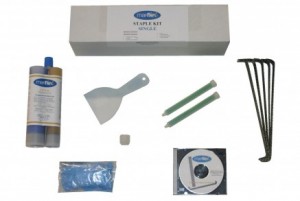
When structural cracks occur in concrete, it is usually caused by movement in the foundation, resulting in long-term moving and fatiguing of concrete. The cracks are the result of movement in the foundation, due to stress forces. To this end, epoxy won’t prevent further foundation damage and cracking.
This is why Mar-flex developed a carbon staple solution that provides the necessary reinforcement. By cross-stitching the countersunk staples within the foundation crack area, movement and fatigue are eliminated and long-term performance of repair materials is improved.
Browse our product selection today, or call, email, or chat with a Mar-flex cross-trained customer service representative through our website chat portal. Simply accept the invite when you enter our website!
Twip of the Day – Applying Crystalline Waterproofing
 Crystalline waterproofing materials are a great way to protect your basement walls from water damage and freezing. Crystalline waterproofing material is applied to basement walls and penetrates into the porous cavities of the cement. This changes the porous concrete into a waterproof solid. It is most effective in a wet basement where water seepage is a problem. Another advantage to using this material is that installation is straightforward and can be accomplished by any do-it-yourself homeowner.
Crystalline waterproofing materials are a great way to protect your basement walls from water damage and freezing. Crystalline waterproofing material is applied to basement walls and penetrates into the porous cavities of the cement. This changes the porous concrete into a waterproof solid. It is most effective in a wet basement where water seepage is a problem. Another advantage to using this material is that installation is straightforward and can be accomplished by any do-it-yourself homeowner.
The first step when applying crystalline waterproofing material is to clean concrete wall surfaces. The crystalline waterproofing material will only adhere to the concrete surface if it is free from any other obstructions, so use a wire brush to clean off any loose concrete or paint. A hammer and chisel may be needed for large pieces of concrete that need removed. If there are multiple layers of paint that cover a wide area, you could try power washing the surface or even sandblasting it.
The next step is to repair your concrete surface. If there has been water leaking through the surface o the concrete, you will need to do some repair work before applying the waterproofing material. Use a shop vac to suck up any of the dirt and loose concrete in the cracks or crumbling areas. Mix up some concrete patch, or use some liquid concrete in a tube. Spread it over the surface with a trowel and make sure the entire crack is full of patching solution. Let it dry and set before doing anything else to the surface.
Next you should wet the surface of the concrete with water. Before you apply any of the waterproofing material, wet the concrete thoroughly. You don’t 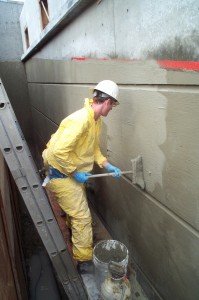 want to soak the area, but it should be wet before you apply any of the waterproofing material.
want to soak the area, but it should be wet before you apply any of the waterproofing material.
In a bucket, you should mix the crystalline waterproofing material with water. Apply just enough water so that the material becomes a thick paste, and don’t be alarmed when it starts to heat up. The chemical process of the water and the material creates this chain reaction.
Once the material is mixed to a thick paste, apply a thick coating to the concrete wall. Use a masonry brush to spread the waterproofing material over the surface of the wall. It should be thick but even throughout.
Once the crystalline waterproofing material is applied to the surface of the concrete, you must keep it wet for at least 48 hours. This is so that the materials will penetrate into porous concrete. If it sets too quickly, it won’t have a chance to combine correctly with concrete.
Another way to apply this type of waterproofing material is to sprinkle it over new concrete pours. If you are building a new foundation, sprinkle the material over the surface of wet concrete. As the concrete dries, it will cause the material to solidify inside the wall, creating a waterproof seal.
Vortex Vents – The Future of Ventilation
 One of the most important aspects of habitable basement environments is proper ventilation. To this end, contractors usually feel that the foundation walls, once back-filled, are out of sight and out of mind until ugly water problems rear their head. Once this water and dampness develops, it allows mold, mildew, and other dangerous hazards to propagate in your environment. This is why Mar-flex invented the Vortex Vent System. Its the first vent system in the word to be durable, adjustable, and built from materials that exceed even the highest expectations.
One of the most important aspects of habitable basement environments is proper ventilation. To this end, contractors usually feel that the foundation walls, once back-filled, are out of sight and out of mind until ugly water problems rear their head. Once this water and dampness develops, it allows mold, mildew, and other dangerous hazards to propagate in your environment. This is why Mar-flex invented the Vortex Vent System. Its the first vent system in the word to be durable, adjustable, and built from materials that exceed even the highest expectations.
Vortex vents have been called the future of foundation ventilation, and the last vent you’ll ever need. Why do experts give us this accreditation? Its because Vortex Vent Systems are adjustable and telescopic, making them the most versatile solution on the market. Also, Vortex is built with a one-size-fits-all mentality in that Vortex comes in two models that can expand or contract to fit any need. Vortex vents are manufactured from high-density polyethylene, offering resistance to chemical corrosion, and longevity.
Check out our product selection in our online product catalog, or contact us by phone at (800) 498-1411, email us, or take advantage of our new website chat interface – where you can chat with a knowledgeable and cross-trained customer service representative who will be happy to answer any questions that you might have.
Twip of the Day – Selecting the Best Sump Pump
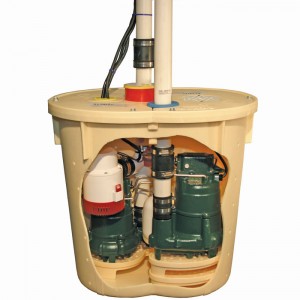 Basement sump pump help prevent the common issue of basement flooding. Choosing the right system that fits your home will save you money and costly repairs later on. Our guide has a few suggestions to keep in mind while you shop for sump pumps.
Basement sump pump help prevent the common issue of basement flooding. Choosing the right system that fits your home will save you money and costly repairs later on. Our guide has a few suggestions to keep in mind while you shop for sump pumps.
First, the amount of power you need for your sump pump will be determined by the threat of floods, and not the size of your home or basement. The best pumps on the market discharge one gallon per second, while maintaining adequate pumping capacity based on the height of your basement. So you should measure the size of your basement from floor to ceiling. The sump pump will need to be able to discharge enough water to fill the basement. While the chances of your basement flooding to the ceiling are minute, you need to be sure your pump can handle a large capacity.
Also, pump are available in a wide variety of case housings. Many customers opt for thin sheet metal type housings. While this helps out over a short period of time, thin sump pump housing are not permanent solutions. Cast iron housings are more expensive, but they will last for the lifetime of the pump. You may find plastic housings on the market, and these should only be used in areas that are at low risk for floods, or as a temporary fix.
Twip of the Day – Is Radon Sealer Necessary
 Radon gas is notorious for seeping and accumulating into confined areas of structures, like basements. Radon gas is colorless, odorless, and tasteless, meaning the only way you can detect it by using a radon gas detector. Its estimated that one in fifteen homes experience high levels of this harmful gas. Scientists have discovered that radon causes cancer and claims around 21,000 lives yearly. There isn’t a required test for radon, though it can be found in nearly every state. The worst part about radon is that it is the second leading cause of lung cancer in the US alone. Several published studies have concluded that your chances of contracting lung cancer from minute radon exposure increased by 11 to 21 percent over an exposure period of 5 years. The gas seeps into your home through cracks and holes in your basement floor. You can stop this
Radon gas is notorious for seeping and accumulating into confined areas of structures, like basements. Radon gas is colorless, odorless, and tasteless, meaning the only way you can detect it by using a radon gas detector. Its estimated that one in fifteen homes experience high levels of this harmful gas. Scientists have discovered that radon causes cancer and claims around 21,000 lives yearly. There isn’t a required test for radon, though it can be found in nearly every state. The worst part about radon is that it is the second leading cause of lung cancer in the US alone. Several published studies have concluded that your chances of contracting lung cancer from minute radon exposure increased by 11 to 21 percent over an exposure period of 5 years. The gas seeps into your home through cracks and holes in your basement floor. You can stop this  from accumulating by sealing your basement floor with an effective sealing product.
from accumulating by sealing your basement floor with an effective sealing product.
Mar-flex Waterproofing and Building Products recognizes the dangers of radon gas and have developed a solution through the new UltriSeal product. UltriSeal is versatile, able to applied to any concrete surface and guaranteed to protect against radon gas penetration through your foundation. You can find our various sealants inside our online product catalog, and call us, email us, or chat with us over the new chat interface if you need assistance or have questions.
Mar-flex Does Foundation Coating Right
 Mar-flex Waterproofing and Building Products are dedicated to quality products that are inexpensive and provide unsurpassed value for the customer. To this end, Mar-flex’s foundation coating products stand at the peak of effectiveness, pushing product capabilities to their limits. Our solvent based foundation coating forms a smooth, rubber-like film when its dry. This coating has good resistance to temperature changes, flexibility at low temperatures, excellent weatherability, and unparalleled resistance to water penetration. Mar-flex Cavity Wall and Foundation Coating is compatible with each Mar-flex Drainage and Insulation Board. Check out our line of products today or contact us by phone, email, or by chatting with our customer service representatives over the Mar-flex Customer Service Chat. Just accept the invitation when you enter our website.
Mar-flex Waterproofing and Building Products are dedicated to quality products that are inexpensive and provide unsurpassed value for the customer. To this end, Mar-flex’s foundation coating products stand at the peak of effectiveness, pushing product capabilities to their limits. Our solvent based foundation coating forms a smooth, rubber-like film when its dry. This coating has good resistance to temperature changes, flexibility at low temperatures, excellent weatherability, and unparalleled resistance to water penetration. Mar-flex Cavity Wall and Foundation Coating is compatible with each Mar-flex Drainage and Insulation Board. Check out our line of products today or contact us by phone, email, or by chatting with our customer service representatives over the Mar-flex Customer Service Chat. Just accept the invitation when you enter our website.
Twip of the Day – Fixing Basement Floor Cracks
 If you notice cracking on your basement floor, you need to consider using a concrete floor filler. This is a product that you can purchase at most home improvement stores, and is similar to concrete without actually being concrete. Concrete filler won’t crack out, and it will adhere to the surface of your existing concrete. Depending on the size of the crack, application can be completed with a trowel (for large cracks) or a caulk gun (for small cracks).
If you notice cracking on your basement floor, you need to consider using a concrete floor filler. This is a product that you can purchase at most home improvement stores, and is similar to concrete without actually being concrete. Concrete filler won’t crack out, and it will adhere to the surface of your existing concrete. Depending on the size of the crack, application can be completed with a trowel (for large cracks) or a caulk gun (for small cracks).
Mar-flex Waterproofing and Building Products offers several concrete repair products. We make it easier than ever by offering the consumer a single use crack repair kit, staple kit, and all the accessories to make the repair the best way. Browse our selection today, or call us, email us, or chat with us on the new web chat interface – able to be accessed by accepting the invitation received when entering our website.
ModularWells by Mar-flex
 ModularWells Modular Egress window wells by Mar-flex fit 32″ to 48″ wide slider or casement windows. ModularWells feature built in steps and ladder which offers safe and easy egress in the event of an emergency. The lightweight, easy to handle modular design allows you to increase height of the well as you need it, simply by adding additional modules in increments of 14″. Mounting flanges help by attaching the ModularWells window well directly to the foundation. Our wells are made from high-performance polyethylene materials, with built-in UV inhibitors and good resistance to weather conditions like freezing or thawing. Our ModularWells are available in attractive earth tones, and the optional hardware installation kit makes installing your new window a breeze.
ModularWells Modular Egress window wells by Mar-flex fit 32″ to 48″ wide slider or casement windows. ModularWells feature built in steps and ladder which offers safe and easy egress in the event of an emergency. The lightweight, easy to handle modular design allows you to increase height of the well as you need it, simply by adding additional modules in increments of 14″. Mounting flanges help by attaching the ModularWells window well directly to the foundation. Our wells are made from high-performance polyethylene materials, with built-in UV inhibitors and good resistance to weather conditions like freezing or thawing. Our ModularWells are available in attractive earth tones, and the optional hardware installation kit makes installing your new window a breeze.
Check out our selection of window wells today, or browse our online product catalog. Remember, you can contact Mar-flex by email, contact us by phone, or utilize our brand new web chat interface, simply by accepting the invitation after entering our website.
Twip of the Day – Facilitating Proper Sump Drainage
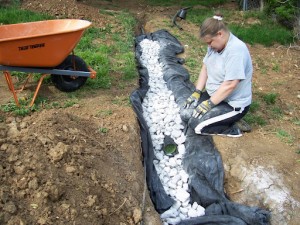 Most homeowners that have sump pumps installed know how to turn them on and off, as well as the right area where the pump should be placed. But, how many homeowners take into consideration where that water is going. It is easy just to stick the outgoing pipe outside to let it seep into the ground. However, sump pump owners should know they are responsible for where they put that water they pump out.
Most homeowners that have sump pumps installed know how to turn them on and off, as well as the right area where the pump should be placed. But, how many homeowners take into consideration where that water is going. It is easy just to stick the outgoing pipe outside to let it seep into the ground. However, sump pump owners should know they are responsible for where they put that water they pump out.
A sump pump has a pipe that water travels through to eliminate excess, so it doesn’t build up in your basement. At the end of the pipe a weather-proof tube is attached, which is flexible and meant to bend and maneuver around objects in order to get the end of the hose away from your foundation. The point of the hose is not really a point that ever gets much consideration.
One thing you should know is that your hose should end at least 10 feet from the foundation of your home, but for efficiency should be closer to 20 feet. If it is any closer, the water will be reabsorbed by the soil, and you’ll pump the same water repeatedly. This constant water flow will wear down your foundation and contribute to erosion and structural damage.
Even if you pump the water 20 feet away from your structure, there are still many things to consider. The location you choose should not be near a septic tank. If you often 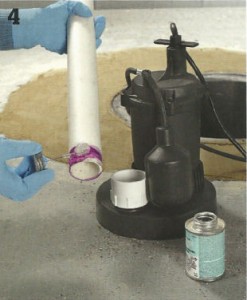 experience moist conditions, your septic tank is probably already dealing with an overload of water. It definitely doesn’t need water added to the load it already has.
experience moist conditions, your septic tank is probably already dealing with an overload of water. It definitely doesn’t need water added to the load it already has.
Also, it is illegal in most places to let your sump pump drain into the local sewer system. The consequences are often more than a large fine and a slap on the wrist, especially if newspapers begin calling you a “neighborhood polluter”.
Allowing your sump pump to drain into a neighbor’s lot is not only discourteous, but also against the law in most places. This is only going to add unneeded water to their land, and they won’t be appreciating it. You could be held liable for contaminants in the water. For instance, if your neighbor grows prize-winning vegetables and suddenly they come out diseased and malformed, tensions will escalate when they discover why – because you drain your dirty water into their yard.
Finally, you should check to make sure the tubing is securely attached to the PVC pipe, so that it doesn’t leak out and get reabsorbed by the foundation. This will lead to corrosion that we mentioned earlier, and will put your sump pump under more of a load than is needed. This will lessen the life of your pump and cost you money for replacements.
